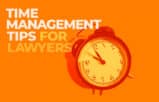Don’t let tracking billable time be a headache. Litigator and legal fees expert Jacqueline Vinaccia has strategies to reduce the stress of billing.

Table of contents
- Don’t Let It Be a Headache
- 1. Don’t think of it as “doing my time.”
- 2. Record time spent when it’s performed.
- 3. Record the interruptions in long projects as they occur.
- 4. Create a distraction-free zone for larger projects.
- 5. Keep a notepad for writing down tasks that occur away from the office.
- 6. Review your firm’s time and billing program.
- 7. Review the efficiency of your staff.
- 8. Communicate with the client regularly.
- 9. Consider alternative billing arrangements.
Filling out a daily timesheet or inputting time into your firm’s billing software can certainly be aggravating, even stressful. The annoying timer. The big blank timesheet. The blinking cursor on the computer screen that greets you every morning. It constantly shows if we are working too hard to enjoy life, working too little to make our minimums, or working inefficiently.
Don’t Let It Be a Headache
Nearly every law firm has a minimum billable hour requirement, typically 1,800 to 2,000 hours per year. This means a goal of approximately 7.7 billable hours per day — if you don’t take a vacation, get sick or work weekends. Research shows that as much as two hours per workday is lost to non-billable tasks. So a lawyer needs to be at work 9.7 hours per day to bill 7.7. This makes capturing billable time incredibly important.
How can you reduce stress? Here are some strategies.
1. Don’t think of it as “doing my time.”
In nearly every case, recording the time you spend working is how you are compensated. You are paid for providing a service. If you are satisfied with the service you provide, be comfortable billing the client for the service. Does your mechanic feel bad for spending two hours replacing your radiator? I have never had a mechanic feel bad about taking my payment for labor.
2. Record time spent when it’s performed.
Don’t aggregate time at the end of the day. It takes approximately 10 seconds to input a time entry at the time the service is performed. Waiting until the end of the day or, worse, the week or month requires an investment of non-billable time as a data-entry person. Not to mention the time lost trying to remember everything you did. Studies show that when time is recorded contemporaneously, the total time billed increases. I’m not talking about bill padding. This is a billable event recorded at the time the service is rendered when it is most likely to be accurate.
3. Record the interruptions in long projects as they occur.
Most workdays involve a series of long projects and the short tasks that occur as interruptions to a longer project: phone calls, emails, etc. If you record the interruptions as they occur, the time can be subtracted from the total time spent working to provide actual-time devoted to the long project.
4. Create a distraction-free zone for larger projects.
Writing motions, briefs and legal opinions requires focus. Phone calls, emails, and staff conferences interrupt that focus, requiring you to refocus every time you return to the project. It can lead to incorrect self-editing of time spent on a project at the end of the day. It probably did not take a full four hours to write that much of your argument. However, dealing with intermittent interruptions can cause you to lose several hours of productive time every day. So, when working on a large project, close your door, turn off email alerts, put a do-not-disturb message on your phone, silence your cell phone, and tell your secretary to interrupt you only for things that truly cannot wait. A good, focused three to four hours will provide quality work product, then give you time to respond to emails and phone calls afterward — maximizing your productivity.
5. Keep a notepad for writing down tasks that occur away from the office.
Meetings, court appearances, and depositions out of the office are, of course, billable. But you also check messages and answer calls and respond to emails when you are out. Keeping a notepad handy to write down all tasks performed when you are out of the office can assist in capturing billable time that could otherwise be forgotten.
6. Review your firm’s time and billing program.
Is it as efficient as it can be? Several programs now have the ability to capture and record time remotely using your smartphone or tablet, allowing you to input time directly into the billing program (without the need for a paper notepad). This is especially useful for litigators who are often out of the office.
7. Review the efficiency of your staff.
Are you spending time on non-billable work when it could be performed by staff? I learned the importance of a good litigation secretary and paralegal when I first started at the firm where I now head the litigation team. Before I started at my firm, I had only ever worked with litigation secretaries and paralegals. The amount of information I did not know about non-billable clerical tasks such as service requirements, filing deadlines, subpoenas, deposition schedules, and court forms was staggering. If you find that you are spending a regular portion of your day on non-billable clerical tasks, review your situation and figure out how to pass these tasks to paraprofessionals or clerical staff. If your staff is not able to handle these tasks, figure out why and fix the problem, whether through education, increased staffing, or even replacing underqualified staff.
8. Communicate with the client regularly.
While large corporations often have regular reporting requirements for outside counsel, most of the rest of us do not and often avoid repeated reporting to prevent incurring fees for unnecessary letters, emails, or phone calls. However, keeping the client informed of the status of a case and the amount of the invoice on a regular basis will reduce stress for both of you. Your client won’t be surprised by the bill if the running total is regularly communicated. And, if necessary, you can strategize together about ways to manage the potential cost while there is still time to do something about it.
9. Consider alternative billing arrangements.
It is true that the billable hour model does not promote efficiency. Flat fees may promote efficiency, but they don’t work for all legal services. Litigation is a classic example. The amount of time and effort expended on a case often depends on the actions of your opponent. An inexperienced or obstreperous opponent can cause legal bills to rise exponentially. But a hybrid approach to legal billing can work in many instances. For example, you might determine a flat fee for initial work, and then identify specific events for which you will charge additional fees, or switch to an hourly arrangement. Alternatives like this can take the stress out of billing for both client and attorney.
These are only a few recommended strategies for reducing the stress associated with billing. What strategies have worked for you?
115 Illustration ©iStockPhoto.com





















